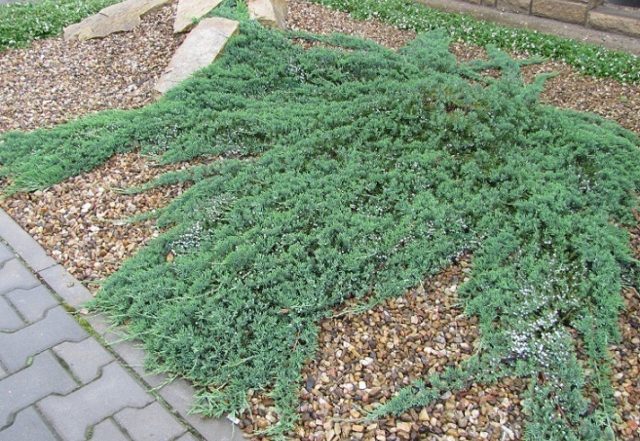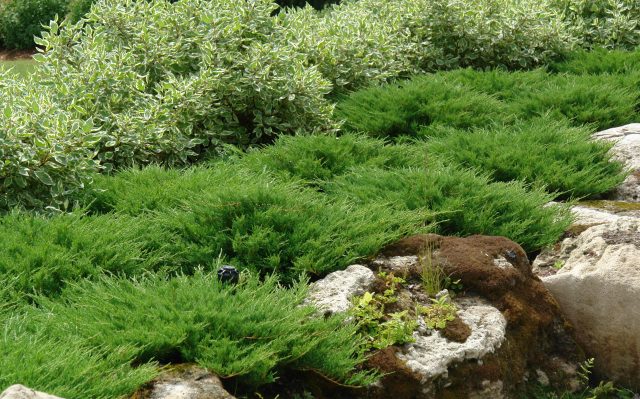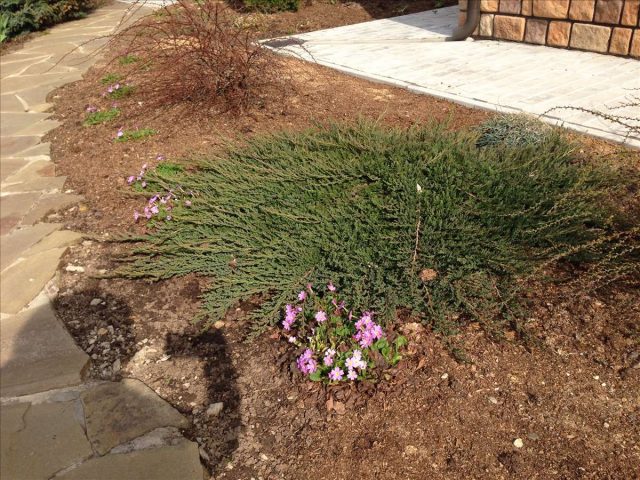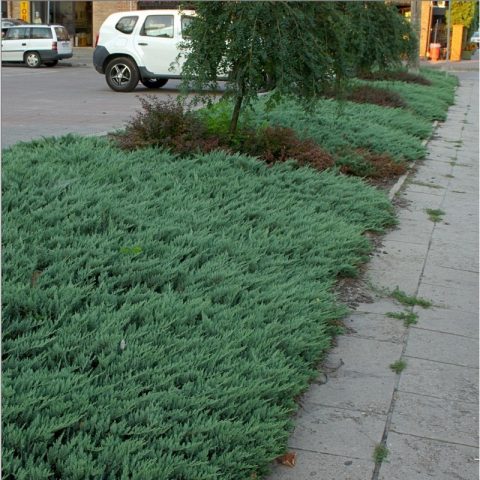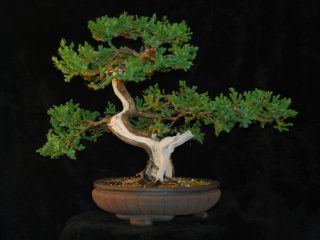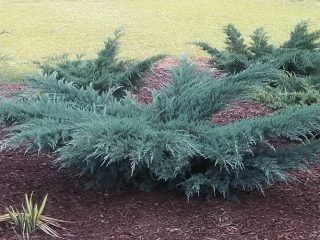Content
- 1 Description Juniper Prince of Wales
- 1.1 Description of Juniper horizontal Prince of Wales:
- 1.2 Juniper horizontal Prince of Wales in landscape design
- 1.3 Planting and caring for junipers horizontal Prince of Wales
- 1.4 Seedling and planting plot preparation
- 1.5 Landing rules
- 1.6 Watering and feeding
- 1.7 Mulching and loosening
- 1.8 Trimming and shaping
- 1.9 Preparing for winter
- 2 Reproduction juniperus horizontalis Prince of Wales
- 3 Diseases and pests of juniper horizontal Prince of Wales
- 4 Conclusion
- 5 Juniper reviews Prince of Wales
The historical homeland of the low-growing coniferous shrub, juniper Prince of Wales - Canada. The variety was created on the basis of a wild crop for the design of sites and park areas. A perennial creeping plant is adapted to low temperatures, tolerates drought and waterlogged soil well.
Description Juniper Prince of Wales
By habitus, a representative of the Cypress family, the horizontal juniper (Juniperus horizontalis Prince of Wales) is the shortest. The species does not have a central trunk; shoots of Prince of Wales juniper grow right next to the root system. Outwardly, each branch looks apart, not as part of the crown, but as an independent plant.
The ornamental shrub grows very slowly, every year it adds 1 cm in height, 6 cm in width. Forms new shoots vertically, when they reach 8 cm, they spread along the surface of the soil. The plant does not belong to the covering type, the branches, being on the soil, do not give a root system without additional cover from above with soil. After 10 years of growing season, the plant is considered an adult, the maximum height of the ornamental shrub is 20 cm, the width of the crown is 2.5 cm.The size of the Prince of Wales juniper depends on the place of growth; in partial shade near the reservoir, the juniper will be larger than in an open sunny area.
Horizontal juniper Prince of Wales (Juniperus horizontalis Prince of Wales) is a frost-resistant plant that easily tolerates temperatures as low as -300 C. Shelter is not required for an adult ornamental shrub. If the juniper is young and the temperature is below -300 C, the crown is covered. The plant does not restore frozen shoots, they are cut off. Given that the shrub grows very slowly, the formation period will last.
Description of Juniper horizontal Prince of Wales:
- Shoots up to 1.5 m long, lowered to the ground, creeping type. As the juniper grows, the upper branches fall on the lower ones, forming a continuous carpet.
- The crown of a young bush is light green, an adult with a silvery tint.
- The needles are in the form of scales, tightly pressed against the shoots, in the fall they have a purple, then dark purple color. It releases insecticides and contains essential oils.
- Fruits are globular, medium-sized, silvery with a blue tinge, firm. The bush gives ovary very rarely.
- The root system is superficial, well-branched, the root circle is 30-50 cm.
Due to its chemical composition (essential oils, trace elements, vitamin complex), Prince of Wales juniper is used in cosmetology. It is added to alcoholic beverages as a flavoring agent.
Juniper horizontal Prince of Wales in landscape design
A low-growing species of juniper, unpretentious in care, grows on almost all soils. Over time, expanding, it forms a dense dense carpet of branches, which are not easy to disassemble.This feature of the coniferous shrub is widely used in the design of home gardens, park areas, flower beds near office buildings. Juniper Prince of Wales in the photo below is presented as an option for a design solution in the design of the site. The solid green mass is visually perceived as an element of the lawn. Juniper gives insignificant growth, does not change during the year and does not require constant pruning.
Due to its exotic, creeping crown, short stature, it is used in group and single plantings. It goes well with low coniferous or flowering shrubs, acts as a foreground. Often used to create:
- imitation of a lawn in rockeries near large stones;
- on the slope of the rock garden or as a central accent;
- on the shore of a small reservoir;
- on flower beds, juniper forms a carpet under which they do not grow weeds, is a common background for flowering crops;
- curbs and slopes of rocky terrain.
A coniferous plant is grown in pots for decorating loggias, balconies, cornices and roofs of a building.
Planting and caring for junipers horizontal Prince of Wales
Dwarf variety Prince of Wales drought-resistant, photophilous, grows well in partial shade near a reservoir. If the bush is located in a place open to the sun, care must be taken to maintain soil moisture. In dense shade under the dense crown of trees, the horizontal juniper Prince of Wales loses its decorative effect. The needles are rarely formed, the needles are small, the crown looks loose, elongated upward, the color of the shoots is faded with yellow fragments.
Prince of Wales undemanding to the composition of the soil. Can grow on poor or saline soils, but always light with adequate drainage. The acid balance is neutral or slightly alkaline. Acidic soils for 6 months before planting are neutralized with lime or dolomite flour is added.
Seedling and planting plot preparation
Prince of Wales juniper planting material can be purchased at the nursery, propagated independently or transferred to another place. The main requirement for a nursery seedling is a well-formed root, branches without dry areas, and needles.
If, in order to reconstruct a site, a juniper is transferred from one place to another, it is necessary to correctly remove it from the soil:
- Raise the branches to the center.
- Gently wrap with a cloth, fix with a rope.
- Dig in in a circle, retreating from the central part by about 0.5 m.
- Deepen, depending on the age of the plant, approximately 40 cm.
- The bush is removed along with the root ball.
You can plant the plant in autumn and spring, the juniper takes root well in a new place.
Before planting work, they dig up a site, make it easier by introducing peat, and add sand to improve drainage. Dig a hole for the bush, it should be 20 cm wider than the root system. The depth is determined by the height of the root to the root collar, taking into account the drainage layer and the soil mixture. On average, a landing pit is 60 * 70 cm in size.
Landing rules
Before placing the Prince of Wales juniper in the planting recess, a fertile mixture is prepared, consisting of equal parts of peat, turf soil, and sand. Ash is added to the mixture at the rate of ¼, it can be replaced with dolomite flour. The plant responds well to substances containing alkali. Algorithm for planting a seedling:
- Drainage (15 cm) is poured at the bottom of the planting hole. Expanded clay, coarse gravel, crushed stone are used.
- The fertile mixture is divided into 2 parts.
- Poured onto the drainage in the pit.
- The seedling, along with a lump of earth, is placed in the center.
- Fall asleep with the rest of the mixture, watered.
A prerequisite is that the root collar should be 2 cm above the surface.Tissue is removed from an adult plant, branches are carefully distributed. The distance between the bushes is determined by design, but not less than 0.5 m from each other.
Watering and feeding
A decorative variety needs a sufficient amount of moisture to form a beautiful crown. After planting, the plant is watered every evening for 2 months. In hot summers, dry air has a negative effect on the needles, they lose their brightness, dries. Top irrigation of the bush is recommended early in the morning or in the evening. Juniper feeding is not required. During the first 2 years, the drug "Kemira Universal" is introduced in early spring (April) - once every 12 months. After 2 years of growth, the Prince of Wales juniper is not fertilized.
Mulching and loosening
Mulching is a mandatory procedure immediately after planting, the root circle is covered with dry leaves, straw, ideally tree bark. The mulch is renewed every fall. Loosening of the soil is not required for an adult plant, the presence of mulch retains moisture and prevents the appearance of a crust on the upper layer of the soil. The weed does not grow under the dense cover of the branches. Loosening of seedlings is carried out at the end of May and in autumn before laying mulch.
Trimming and shaping
Pruning of Prince of Wales juniper is carried out in the spring, it is of a health nature. Remove dry and frozen areas. If the plant overwintered without disturbing the crown, pruning is not required for the evergreen ephedra.
A bush is formed at will, the natural decorativeness of the culture is quite high. If the design decision is not in favor of the entire occupied area of the crown, the tops of the branches are shortened to the required length. The growth of the juniper is slow, the formed bush will retain its shape for several years.
Preparing for winter
Preparatory measures for the winter period are necessary for young seedlings, the culture is frost-resistant, an adult plant does not need shelter. Works are carried out in late autumn:
- Fall asleep with straw, leaves, sawdust or tree bark, the root circle with a layer of 10-15 cm.
- The branches are collected in a bunch so that they do not break under a layer of snow.
- From above, the plant is covered with spruce branches or arcs are installed and the film is stretched.
- Water-charging irrigation is preliminarily carried out.
Reproduction juniperus horizontalis Prince of Wales
The most common breeding method for Prince of Wales juniper is by rooting cuttings. In the spring, the shoot is fixed to the soil, covered with soil from above, they make sure that the amount of soil does not decrease, if necessary, fill it up. After a year, the plant will form a root system, the layers are separated from the bush and planted on the site.
Juniper can be propagated by cuttings from shoots. The optimum age of the branches for cuttings is 2 years. Planting material is harvested in spring or autumn, cuttings are placed in fertile soil, planted after rooting.
You can get a plant by grafting. The method is laborious, rarely used, the Prince of Wales juniper does not take root well on a trunk of another species.
The culture can be propagated by seeds, but the planting material of the Prince of Wales hybrid does not retain varietal characteristics. The result is a dwarf bush that vaguely resembles the mother plant.
Diseases and pests of juniper horizontal Prince of Wales
The Prince of Wales, like any juniper, releases insecticides, which are toxic to most garden pests. Parasite on juniper:
- aphid - in the fight against the pest, they destroy the ant colonies and cut off the branches where the main amount of the parasite has accumulated;
- spider mite - eliminate with colloidal sulfur;
- scabbard - sprayed with special insecticides;
- juniper sawfly - the larvae are collected, treated with "Karbofos".
Fungal infection is stopped with copper sulfate.
Conclusion
Juniper Prince of Wales is appreciated by designers for the decorative crown. The dwarf shrub does not shed its needles in the fall, only changes color from bright green to purple-plum. The culture is frost-resistant, does not require constant pruning and crown formation. They are used as a ground cover plant for decorating the landscape of squares, parks, and personal plots. Planted on several levels of rockeries or alpine hills, it forms an airy, flowing cascade.
